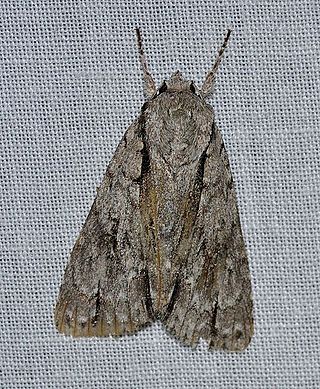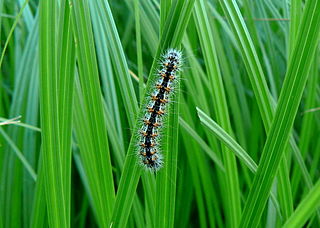
Acronicta is a genus of noctuid moths containing about 150 species distributed mainly in the temperate Holarctic, with some in adjacent subtropical regions. The genus was erected by Carl Linnaeus in his 1758 10th edition of Systema Naturae. Caterpillars of most Acronicta species are unmistakable, with brightly colored hairy spikes, and often feed quite visibly on common foliate trees. The hairy spikes may contain poison, which cause itchy, painful, swollen rash in humans on contact. The larva of the smeared dagger moth is unusually hairy even for this genus. Acronicta species are generally known as dagger moths, as most have one or more black dagger-shaped markings on their forewing uppersides. But some species have a conspicuous dark ring marking instead.

Acronicta rumicis, the knot grass moth, is a species of moth which is part of the genus Acronicta and family Noctuidae. It was first described by Carl Linnaeus in his 1758 10th edition of Systema Naturae. It is found in the Palearctic region. A. rumicis lives and feeds on plants located in wide-open areas. At its larval stage, as a caterpillar, it causes such a large impact as a crop pest that it has received much attention and research. A. rumicis feeds on maize, strawberries and other herbaceous plants.

Acronicta tritona, the Triton dagger moth, is a moth of the family Noctuidae. The species was first described by Jacob Hübner in 1818. It is found in eastern North America, from Nova Scotia west to north-eastern Alberta, south to Florida and Texas, and west to Oregon.

Acronicta sperata, the hopeful dagger moth, is a moth of the family Noctuidae. The species was first described by Augustus Radcliffe Grote in 1873. It is found in North America from New Brunswick west to the Alberta foothills, south to the District of Columbia, Missouri and in the mountains to Colorado.

Acronicta fragilis, the fragile dagger moth, is a moth of the family Noctuidae. The species was first described by Achille Guenée in 1852. It is found in North America from Newfoundland to Florida, west across Canada, south to Kentucky and Minnesota. It is listed as a species of special concern in the US state of Connecticut.

Acronicta hasta, the forked dagger moth, speared dagger moth, cherry dagger moth or dart dagger moth, is a moth of the family Noctuidae. The species was first described by Achille Guenée in 1852. It is found in North America in the eastern deciduous woodlands, ranging west across southern Saskatchewan and Alberta into central southern British Columbia, south to Tennessee, Wisconsin and Kansas.

Acronicta impressa, the impressive dagger moth or willow dagger moth, is a moth of the family Noctuidae. The species was first described by Francis Walker in 1856. It is found from western Canada to north-western Mexico.

Acronicta longa, the long-winged dagger moth, is a moth of the family Noctuidae. The species was first described by Achille Guenée in 1852. It is found across much of North America, with Nova Scotia, Alberta, Florida, and Texas within is range.
Acronicta vulpina, the vulpina dagger moth or miller dagger moth, is a moth of the family Noctuidae. The species was first described by Augustus Radcliffe Grote in 1883. It is found in North America from New York and Newfoundland west to central British Columbia, south to Colorado.

Acronicta heitzmani, or Heitzman's dagger moth, is a moth of the family Noctuidae. The species was first described by Charles V. Covell and Eric H. Metzler in 1992. It is found in Missouri, Arkansas, Illinois and Ohio.

Acronicta modica, the hesitant dagger, is a moth of the family Noctuidae. It is found in eastern North America from Nova Scotia to Florida, west to Oklahoma and Texas.

Acronicta fallax, the green marvel, is a moth of the family Noctuidae. The species was first described by Gottlieb August Wilhelm Herrich-Schäffer in 1854. It is found in most of North America, from Ontario, Quebec, New Brunswick, Nova Scotia, Newfoundland and Labrador and Manitoba south to Arizona and Florida.

Acronicta insularis, the cattail caterpillar or Henry's marsh moth, is a moth of the family Noctuidae. The species was first described by Gottlieb August Wilhelm Herrich-Schäffer in 1868. It is found from coast to coast throughout the United States and southern Canada.

Acronicta insita, the large gray dagger or fingered dagger, is a moth of the family Noctuidae. The species was first described by Augustus Radcliffe Grote in 1874. It is found from Newfoundland west to the Pacific coast and Vancouver Island and Haida Gwaii, British Columbia, south to North Carolina and Colorado.
Acronicta atristrigatus is a species of moth in the family Noctuidae.

Acronicta spinea is a species of moth in the family Noctuidae.
Acronicta rapidan is a species of moth in the family Noctuidae. It is found in North America.
Acronicta sagittata is a moth in the family Noctuidae. The species was first described by James Halliday McDunnough in 1940. It is found in North America.
Acronicta australis is a species of moth in the family Noctuidae. It is found in North America.

Acronicta immodica, the medium dagger, is a species of owlet moth in the family Noctuidae. It is found in eastern North America.













